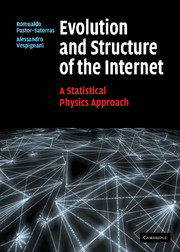Book contents
- Frontmatter
- Contents
- Preface
- List of abbreviations
- 1 A brief history of the Internet
- 2 How the Internet works
- 3 Measuring the global Internet
- 4 The Internet's large-scale topology
- 5 Modeling the Internet
- 6 Internet robustness
- 7 Virtual and social networks in the Internet
- 8 Searching and walking on the Internet
- 9 Epidemics in the Internet
- 10 Beyond the Internet's skeleton: traffic and global performance
- 11 Outlook
- Appendix 1 Graph theory applied to topology analysis
- Appendix 2 Interface resolution and router topology
- Appendix 3 Numerical analysis of heavy tailed distributions
- Appendix 4 Degree correlations
- Appendix 5 Scale-free networks: scaling relations
- Appendix 6 The SIR model of virus propagation
- References
- Index
9 - Epidemics in the Internet
Published online by Cambridge University Press: 12 January 2010
- Frontmatter
- Contents
- Preface
- List of abbreviations
- 1 A brief history of the Internet
- 2 How the Internet works
- 3 Measuring the global Internet
- 4 The Internet's large-scale topology
- 5 Modeling the Internet
- 6 Internet robustness
- 7 Virtual and social networks in the Internet
- 8 Searching and walking on the Internet
- 9 Epidemics in the Internet
- 10 Beyond the Internet's skeleton: traffic and global performance
- 11 Outlook
- Appendix 1 Graph theory applied to topology analysis
- Appendix 2 Interface resolution and router topology
- Appendix 3 Numerical analysis of heavy tailed distributions
- Appendix 4 Degree correlations
- Appendix 5 Scale-free networks: scaling relations
- Appendix 6 The SIR model of virus propagation
- References
- Index
Summary
The Internet is a technological infrastructure aimed at favoring data exchange and reachability. The World Wide Web can be used to extract information from distant places with a few mouse clicks, and Internet protocols forward messages to far away computers, efficiently routing them along the intricate network fabric. This extreme efficiency, however, can also work in favor of negative purposes, such as the spreading of computer viruses. Computer viruses have a long history, dating from the 1980s and before, becoming newly and sadly famous after each new bug attack, which eventually causes losses worth millions of dollars in computer equipment and downtime (Suplee, 2000). Their ever-increasing threat has therefore stimulated a growing interest in the scientific community and the economic world, translated in this latter case into the antivirus software business, moving millions of dollars worldwide every year.
Computer virus studies have been carried out for long time, based mainly on an analogy with biological epidemiology (Murray, 1988). In particular most studies have focused on the statistical epidemiology approach, aimed at modeling and forecasting the global incidence and evolution of computer virus epidemics in the computer world. The final goal of this approach is the development of safety and control policies at the large-scale level for the protection of the Internet. Puzzling enough, however, is the observed behavior of computer viruses in the wild, which exhibit peculiar characteristics that are difficult to explain in the usual epidemic spreading framework.
- Type
- Chapter
- Information
- Evolution and Structure of the InternetA Statistical Physics Approach, pp. 180 - 210Publisher: Cambridge University PressPrint publication year: 2004
- 1
- Cited by



